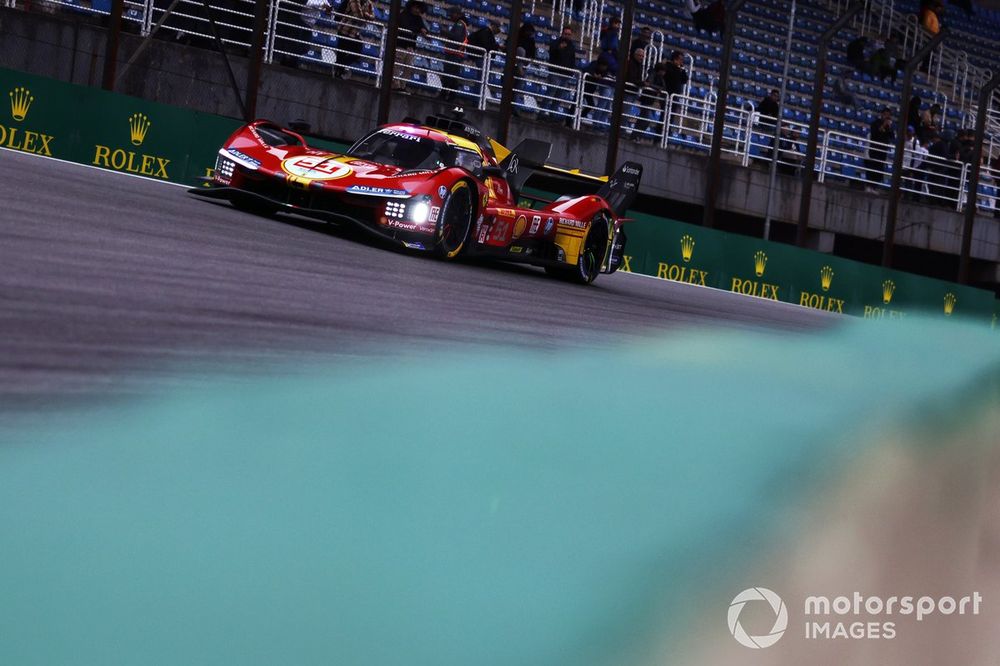Ferrari’s victory at the Le Mans 24 Hours was one of the factors behind the early introduction of the first evo joker upgrade of its 499P for Interlagos this weekend.
The Italian manufacturer explained that it brought the revision focussed on rear brake cooling of its Le Mans Hypercar to the Brazilian round of the World Endurance Championship in order to prepare for the latter rounds of the series when there will be a premium on braking efficiency, most specifically Bahrain in November.
“We decided considering the good results we had in Le Mans and the fact that we are back fighting for the championship that it could be an idea [to introduce it for this weekend] given that we were ready to start with this modification immediately after Le Mans,” said Ferrari sportscar racing technical director Ferdinando Cannizzo.
“As long as we had this improvement in the pocket, why not start directly? This will give us the opportunity to get familiar with this modification — we need to re-adjust.”
“This is one of the reasons why we said, yes we come here to gain experience for when we will go to race on tracks that are really stressful for brakes.”
Ferrari opted not to employ one of the five evo jokers allowed to it during the initial five-year lifecycle of the 499P at the start of the current campaign, which is the car’s second season. It then said at Le Mans this year that it would bring an update either before the end of this season or for the start of the next.
Cannizzo revealed that there were two reasons why Ferrari never considered running it at Le Mans where Antonio Fuoco, Nicklas Nielsen and Miguel Molina notched up the 499P’s second victory in a row at the French enduro.
The first was that Le Mans is not, Cannizzo said, “stressful for the brakes” and the second was that the rule makers – the FIA and the Automobile Club de l’Ouest – demanded that it be on the 499P for two WEC rounds beforehand in order for its effect to be assessed for the Balance of Performance.
That would have meant blooding the modification at the Imola WEC round in April, which would have been too early in the development of the upgrade.

#51 Ferrari AF Corse Ferrari 499P: Alessandro Pier Guidi, James Calado, Antonio Giovinazzi
Photo by: JEP / Motorsport Images
The modification of the brake cooling at the rear has been undertaken “so not as to give us a compromise in the set-up choice”, explained Cannizzo. He added that he did “not expect any big changes in performance” as a result.
Changing the brake cooling package meant Ferrari had to rebalance the aerodynamics of the 499P to maintain its position within the aero performance window laid down in the LMH regulations.
Cannizzo confirmed that the underfloor had been changed as a result and that the upper body surfaces “have been touched a bit”.
The most obvious visual difference on the updated car is the revisions to the front diveplanes or flicks.
Cannizzo revealed that Ferrari was evaluating further performance upgrades, which are subject to the approval of the FIA and the ACO, but would not be drawn on any timeline for their introduction.
“We are very prudent, cautious about changing things on the car,” he said. “But this is not impeding us from keeping working and trying to find improvements.
“This work is going on, but when we will arrive with something new I do not know.”
Victory in the double-points Le Mans WEC round propelled Fuoco, Nielsen and Molina from fifth to second in the drivers’ championship. They now lie nine points behind Porsche trio Laurens Vanthoor, Kevin Estre and Andre Lotterer.
Ferrari is also second in the manufacturers’ classification.








